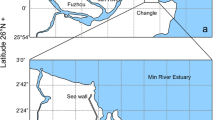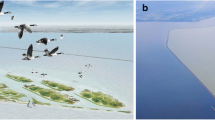Abstract
Here we demonstrate, through experimental iron additions to a Mediterranean seagrass meadow, that iron plays a pivotal role in seagrass systems on carbonate sediments, directly through its role as a limiting nutrient, and indirectly by stimulating phosphorus recycling through the activity of the enzyme alkaline phosphatase and by buffering the development of reduced conditions in sediments. Iron additions were performed throughout the active root zone (30 cm depth) to two Posidonia oceanica meadows, one on organic-enriched sediments and one on organic poor sediments (Reference). Seagrass growth, nutrient incorporation and sediment biogeochemical conditions were followed for four months. Iron additions had positive effects on seagrass growth (leaf production increased with 55%) and nutrient incorporation (increased 46–91%) in the organic-enriched site, increasing to levels found at the Reference site. There was no effect of iron additions in the Reference seagrass meadow suggesting that iron was not the most important controlling factor at this site. The iron pools were about two times higher compared to the organic-enriched site. The main effect on the sediment biogeochemical conditions at the organic-enriched site was a suppression of sulfate reduction activity to the levels encountered at the Reference site (6.7 mmol m−2d−1 vs. 4.7–5.9 mmol m−2d−1). This suggests that the sulfide stress on the seagrasses was removed and that the iron availability increased due to reduced precipitation of iron-sulfides and thus improving seagrass growth conditions in these organic-enriched sediments.






Similar content being viewed by others
References
Alcoverro T, Manzanera M, Romero J. 2000. Nutrient mass balance of the seagrass Posidonia oceanica: the importance of nutrient retranslocation. Mar Ecol Progr Seri 194:13–21
Ballesteros E, Zabala M. 1993. El bentos: el marc físic. In: Alcover JA, Ballesteros E, Fornós JJ, Eds. Història natural de l’Arxipèlag de Cabrera. Monografies de la societat d’Història Natural de les Illes Balears 2, Editorial Moll-CSIC, Palma de Mallorca. pp 663–85
Berner RA, 1984. Sedimentary pyrite formation: An update. Geochim Cosmochim Ac 48:605–15
Bower CE, Holm-Hansen T. 1980. A salicylate-hypochlorite method for determining ammonia in seawater. Can J Fish Aquat Sci 37:794–98
Burdige DJ, Zimmerman RC. 2003. Impact of sea grass density on carbonate dissolution in Bahamian sediments. Limnol Oceanogr 47:1751–63
Cembella AD, Antia NJ, Harrison P. 1983. The utilization of inorganic and organic phosphorus compounds as nutrients by eukaryotic microalgae: a multidisciplinary perspective: part 1. CRC Cr Rev Microbiol 10:317–91
Chambers RM, Fourqurean JW, Macko SA, Hoppenot R. 2001. Biogeochemical effects of iron availability on primary producers in a shallow marine carbonate environment. Limnol Oceanogr 46:1278–1286
Cline JD. 1969. Spectrophotometric determination of hydrogen sulfide in natural waters. Limnol Oceanogr 14:454–458
Duarte CM, 1990. Seagrass nutrient content. Mar Ecol Progr Ser 67:201–7
Duarte CM. 1992. Nutrient concentrations of aquatic plants: patterns across species. Limnol Oceanogr 37:882–889
Duarte CM. 2002. The future of seagrass meadows. Environ Conserv 29:192–206
Duarte CM, Merino M, Gallegos M. 1995. Evidence of iron deficiency in seagrasses growing above carbonate sediments. Limnol Oceanogr 40:1153–8
Erskine JM, Koch MS. 2000. Sulfide effects on Thalassia testudinum carbon balance and adenylate energy charge. Aquat Bot 67:275–85
Fossing H, Jørgensen BB. 1989. Measurement of bacterial sulfate reduction in sediments: Evaulation of a single-step chromium reduction method. Biogeochemistry 8:205–22
Fu FX, Bell PRF. 2003. Growth, N2 fixation and photosynthesis in a cyanobacterium, Trichodesmium sp., under Fe stress. Biotechnol Lett 25:645–9
Goodman JL, Moore KA, Dennison WC. 1995. Photosynthetic responses of eelgrass (Zostera marina L.) to light and sediment sulphide in a shallow barrier island lagoon. Aquati Bot 50:37–47
Hemminga M, Duarte CM. 2000. Seagrass Ecology. Cambridge University Press, Cambridge, pp 298
Holmer M, 1999. The effect of oxygen depletion on anaerobic organic matter degradation in marine sediments. Estuarine, Coast Shelf Sci 48:383–90
Holmer M, Bondgaard EJ. 2001. Photosynthetic and growth response of eelgrass to low oxygen and high sulfide concentrations during hypoxic events. Aquat Bot 70:29–38
Holmer M, Duarte CM, Marbá N. 2003. Sulfur cycling and seagrass (Posidonia oceanica) status in carbonate sediments. Biogeochemistry 66:223–39
Igarashi RY, Seefeldt LC. 2003. Nitrogen fixation: the mechanism of the Mo-dependent nitrogenase. Crit rev Biochem Mol Biol 38:351–84
Jensen HS, McGlathery KJ, Marino R, Howarth RW. 1998. Forms and availability of sediment phosphorus in carbonate sand of Bermuda seagrass beds. Limnol Oceanogr 43:799–810
Jørgensen BB, 1978. A comparison of methods for the quantification of bacterial sulfate reduction in coastal marine sediments. Geomicrobial J 1:11–27
King GM, Carlton RG, Sawyer TE. 1990. Anaerobic metabolism and oxygen distribution in the carbonate sediments of a submarine canyon. Mar Ecol Prog Ser 58:275–85
Koroleff F. 1983. Determination of nutrients. In: Grasshof K, Ehrhardt M, Kremling K, Eds. Methods of seawater analysis. Verlag Chemie Weinheim, New York, pp 125–39
Ku TCW, Walter LM, Coleman ML, Blake RE, Martin AM. 1999. Coupling between sulfur recycling and syndepositional carbonate dissolution: Evidence from oxygen and sulfur isotope compositions of pore water sulfate, South Florida platform, U.S.A. Geochim Cosmochim Act 63:2529–46
Lee K-S, Dunton KH. 2000. Diurnal changes in pore water sulfide concentrations in the seagrass Thalassia testudinum beds: the effects of seagrasses on sulfide dynamics. J Exp Mar Biol Ecol 255:201–14
Lovley DR, Phillips EJP. 1987. Competitive mechanisms for inhibition of sulfate reduction and methane production in the zone of ferric iron reduction in sediments. Appl Environ Microbiol 53:2636–41
Marbá N, Duarte CM, Cebrián J, Enríquez S, Gallegos ME, Olesen B, Sand-Jensen K. 1996. Growth and population dynamics of Posidonia oceanica on the Spanish Mediterranean coast: elucidating seagrass decline. Mar Ecol Progr Ser 137:203–13
Marbà N, Duarte CM, Holmer M, Martínez R, Basterretxea G, Orfila A, Jordi A, Tintoré J. 2002. Assessing the effectiveness of protection on seagrass (Posidonia oceanica) populations in the Cabrera National Park (Spain). Environ Conserv 29:509–18
Marschner H. 1986. Mineral nutrition of higher plants. Academic Press, London
Moeslund L, Thamdrup B, Jørgensen BB. 1994. Sulfur and iron cycling in a coastal sediment: radiotracer studies and seasonal dynamics. Biogeochemistry 27:129–52
Nielsen SL, Sand-Jensen K, Borum J, Geertz-Hansen O. 2002. Depth colonization of eelgrass (Zostera marina) and macroalgae as determined by water transparency in Danish coastal waters. Estuaries 25:1025–32
Oviatt CA, Quinn JG, Maughan JT, Ellis JT, Sullivan BK, Gearing JN, Gearing PJ, Hunt CD, Sampou PA, Latimer JS. 1987. Fate and effects of sewage sludge in the coastal marine environment: a mesocosm experiment. Mar Ecol Progr Ser 41:187–203
Pedersen O, Binzer T, Borum J. 2004. Sulphide intrusion in eelgrass (Zostera marina L.). Plant Cell Environ 27 [in press]. 5:595–602
Pérez M, Romero J. 1993. Preliminary data on alkaline phosphatase activity associated with Mediterranean seagrasses. Bot Mar 36:499–502
Short FT, Duarte CM. 2001. Methods for the measurement of seagrass growth and production. In: Short FT, Coles RG, Eds. Global seagrass research methods. Amsterdam: Elsevier. pp 155–82
Short FT, Wyllie-Echeverria S. 1996. Natural and human-induced disturbance of seagrasses. Environ Conserv 23:17–27
Stookey LL. 1970. Ferrozine – a new spectrophotometric reagent for iron. Anal Chem 42:779–81
Sørensen J. 1982. Reduction of ferric iron in anaerobic, marine sediment and interaction with reduction of nitrate and sulfate. Appl Environ Microbiol 43:319–24
Thamdrup B, 2000. Bacterial manganese and iron reduction in aquatic sediments. In: Schink B, Ed. Advances in microbial ecology 16. New York: Kluwer Academic/Plenum Publishers, pp 41–84
Thode-Andersen S, Jørgensen BB. 1989. Sulfate reduction and the formation of 35S-labeled FeS, FeS2 and S0 in coastal marine sediments. Limnol Oceanogr 35:793–806
Welsh DT. 2000. Nitrogen fixation in seagrass meadows: Regulation, plant-bacteria interactions and significance to primary productivity. Ecol Lett 3:58–71
Acknowledgement
This research was funded by the M&M’s project, funded by the European Commision’s “Sustainable Marine Ecosystems” key action (Contract number EVK3-CT2000-00044). We thank the managements and staff of the Cabrera Island National Park for access to the Park’s waters, and S. Sørensen, R. Martínez, C. Arrondo, C. Barron and E. Díaz-Almela for assistance. MH was supported by the Danish Natural Science Research Council grant. no. 9901749, 21-02-0463 and 1131.
Author information
Authors and Affiliations
Corresponding author
Rights and permissions
About this article
Cite this article
Holmer, M., Duarte, C.M. & Marbá, N. Iron Additions Reduce Sulfate Reduction Rates and Improve Seagrass Growth on Organic-Enriched Carbonate Sediments. Ecosystems 8, 721–730 (2005). https://doi.org/10.1007/s10021-003-0180-6
Received:
Accepted:
Published:
Issue Date:
DOI: https://doi.org/10.1007/s10021-003-0180-6




